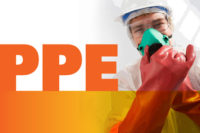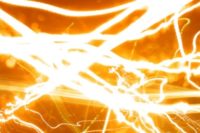Those familiar with these standards know that they are inadequate to build a safety program around without outside help since much of the language is performance-based without clear guidelines on how to comply. Most of industry turns to the national consensus standards such as ANSI/IEEE’s National Electric Safety Code (NESC) (ANSI C-2) or NFPA 70E Electrical Safety in the Workplace. These two standards cover electric utility work and other general industry electrical work respectively.
In 2013, the updated OSHA standards are scheduled to make changes which most companies have yet to implement in their electrical safety training. These critical changes help put electrical safety programs in line with the new law coming in March.
Start using the term “arc-rated (AR)” vs. “flame resistant (FR)” clothing.
The NFPA 70E committee, being an end user standard, has sought to end confusion over the misuse of the term “FR”. FR is a very generic term which only has meaning in the framework of the hazard. Flash-fire rated clothing should meet a flash fire standard (such as NFPA 2112 or for rainwear use ASTM F2733), electric arc hazard clothing should meet an arc standard (such as ASTM F1506, ASTM F1891 for rainwear or ASTM F2178 for hoods, goggles and faceshields) and firefighter clothing should meet a firefighter standard (such as NFPA 1971 Turnout Gear, NFPA 1975 Fire Station-wear or NFPA 1977 Wildland Firefighting). NFPA recently provided a clear statement against misusing NFPA 701 in garments. This standard is not designed for labeling garments and doing so is a misuse of the standard and opens the company labeling garments as flame resistant per NFPA 701 to liability since it is only for “wall coverings,” “curtains,” “furniture” and other building uses but NOT clothing.
n No credit for using cotton, wool or silk under arc rated clothing in NFPA 70E even if you test them.
NESC still allows use of non-FR underlayers to be tested and add protection, but most companies are recognizing only the arc rated layers as adding protection. More and more companies are using arc rated t-shirts and layering to reach the desired protective levels without wearing flash suits. This is most common in utilities or companies employing designated electricians. This more conservative approach has been justified by NFPA 70E due to the variability of non-FR undergarments (no one has tested every undergarment) and the variability of arc exposures (calculating an 8 cal/cm² for a label does not mean you will never have >8 cal/cm² in a real life event).
Preventing non-FR t-shirt ignitions could save several lives per year and reduce injuries in many workers who come in contact with electricity by preventing their clothing from igniting. This can be accomplished by using an arc rated undershirt or ensuring that the outer suit is always at the arc rating required for the work for low voltage work. For layering data, see your garment manufacturer or check out ArcWear.com’s public arc rated layer data (ArcWear.com does not sell clothing and provides multilayer system data free on systems tested by end users through our testing service using ASTM F1959). A phenomenon known as a “tracking arc” provides a compelling reason to use arc rated t-shirts. If electrical contact occurs when working greater than 1000V lines, an arc can track through the clothing or under the clothing and ignite clothing from the inside out. (See Figure 1. Tracking Arc.)
Non-melting zippers, findings and logos.
NFPA 70E 130.7(C)(11) states that AR clothing must meet certain performance characteristics beyond those in ASTM F1506.
“Clothing consisting of fabrics, zipper tapes, and findings made from flammable synthetic materials that melt at temperatures below 315°C (600°F), such as acetate, acrylic, nylon, polyester, polyethylene, polypropylene, and spandex, either alone or in blends, shall not be used.
Informational Note: These materials melt as a result of arc flash exposure conditions, form intimate contact with the skin, and aggravate the burn injury.” ASTM F1506
Flame resistant zipper tapes do exist, but when normal zipper tapes are covered properly they can comply with ASTM F1506. Unfortunately, they now will not comply with NFPA 70E. While we prefer flame resistant zipper tapes in testing, there is a danger in using them without thought. Exposed zipper tapes, like those in a sweatshirt, can break open earlier than the fabric thus making the garment unsafe at exposures below the garment rating. However, due diligence on the part of the manufacturer via testing (using ASTM F2621) or by covering the zipper with adequate protective fabric will prevent ignition.
Arc Tested zippers (zipper tapes are never arc rated but can be evaluated in a garment form) can solve issues of ignition if a zipper is not properly protected in the garment design. Reading the informational note, it could be interpreted that the committee did not intend to eliminate the use of common zipper tapes unless they could make intimate contact with the skin. This has yet to be determined. Currently, that is the interpretation of ASTM F1506 regarding zippers.
Logos are not included in findings because NFPA 70E refers the user to ASTM F1506 which allows non-FR logos as long as their design does not increase the extent of an injury. See NFPA 70E 130.7(C)(13)(d) which points to ASTM F1506 for trim and logos.
New Arc Ratings based on ASTM F1959-06 (or later) with two layer “pre-ablation burn” measurements.
Some clothing systems have been down-rated due to a phenomenon often termed the “double hump”. Some clothing systems, specifically heavy layers over lighter layers, will sometimes allow skin burns BEFORE the outer shell begins to “ablate” or open up to allow cooling immediately after the arc. The ASTM committee made a change to the test method in 2005-2006 addressing this, but NFPA 70E pointed to the 1999 version of the standard F1959 which did not address this. Therefore, some system ratings were artificially higher than those tested after 2005. This also applies to hoods and flash suits even though these systems are not inherently unsafe because of this phenomenon. The principal issue arises when these suits are worn alone (read “naked” under the suit). A coverall tested over a shirt, however, would potentially exhibit this effect and could allow second degree burns in some unusual cases. New systems should have an ASTM F1506-08 or newer label to meet NFPA 70E-2012 requirements. We have encountered many garments with generic NFPA 70 and ASTM F1506 labels that do not meet the new standard.
Arc flash boundary and limited approach boundary now require energized electrical work permit.
Related terms used throughout the document such as: “flash protection boundary” “flash hazard boundary,” “flash boundary” have been modified to the new term “arc flash boundary” and the “arc flash boundary” now clearly requires a written energized work permit [NFPA 130.2 and 130.2(B)(1)]. Previously, this was required at the Prohibited Boundary. Now, it is required at the arc flash boundary or the limited approach boundary whichever the greater distance is. Practically, many companies have a default boundary for energized permits and PPE donning.
Redefined arc flash hood allows flexibility.
The definition of arc flash hood no longer requires a specific design or a “bee-keeper’s style hood”. It now requires 360° protection, and it may be designed without restriction as long as it provides that protection. Newer hoods are now made with hardhats with less fabric and balaclava/goggles are now being used in situations where fabric on top of the hardhat could cause a greater risk of shock. Making the work practice standard less prescriptive and more performance based may allow even more flexibility going forward. (See Figure 2 for an example of a new design.)
Audits (three different NFPA 70E audits and an NESC audit)
Another change in the NFPA 70E standard that should be trained is in regard to auditing. There are four audits required in NFPA 70E and a few implications in NESC which require an audit.
— Supervisory Work Practice Inspection
• NFPA 70E 110.2(D)(1)(f);
• NESC 421.A.2 Supervisor routine auditing;
• NESC 410(A)(2&4) employee retraining when not following work rules, implies a supervisory level audit;
• NESC 420(A)(1) work rule knowledge auditing;
• OSHA 1910.269 (d)(2)(v) LOTO auditing.
Remember this is law for utilities and recommended for all electrical workers.
“1910.269(a)(2)(iii) The employer shall determine, through regular supervision and through inspections conducted on at least an annual basis, that each employee is complying with the safety-related work practices required by this section.(a)(2)(iv) An employee shall receive additional training (or retraining) under any of the following conditions:(a)(2)(iv)(A)If the supervision and annual inspections required by paragraph (a)(2)(iii) of this section indicate that the employee is not complying with the safety-related work practices required by this section.”
— Annual Worksite Audit
Similar to above but focused on the worksite in general. Companies could combine this with the supervisory audit in some situations but the program should be clear and documented. This is electrical specific but could be combined with a safety audit. It should cover electrical safe work practices. The auditor should be knowledgeable of the proper safe work practices in the standards. Many of the audits we have seen focus on NEC wiring issues and little or no audit of work practices. The Annual Worksite Audit is a work-practice procedure audit, not an electrical wiring audit.
— 3-Year Program Audit [NFPA 70E 110.3(H)(1) & NESC 410.A.1, 420.A.1]
Work rules must be written and up-to-date with the latest OSHA and proper consensus standards so NFPA requires a written electrical safety program audit every three years in the 2012 edition of the standard to ensure that it is in line with the standard. This could be done when any of the applicable standards change but most companies have a requirement to audit the program periodically so that the program is updated on a cyclical basis.
Training frequency
New to NFPA 70E is a requirement to retrain every three years. Previously the frequency was not defined. Keeping up with these changes in the consensus standards should help companies on compliance with the new OSHA changes in March and make safety programs more comprehensive on a hazard which is one of the top five killers in the workplace.




